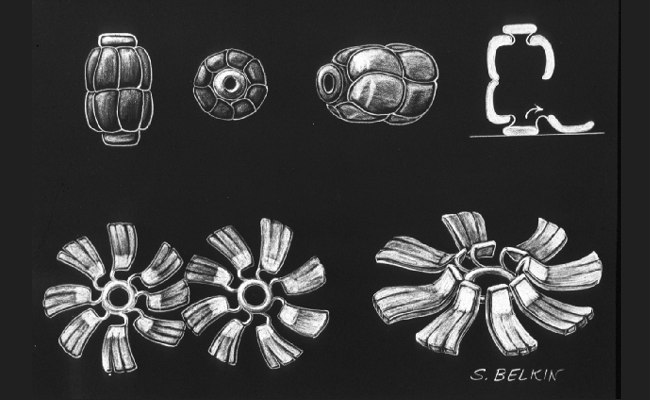Scientists: Vault Structure

Higher order structure of vaults has been elucidated in collaboration with a number of excellent structure groups (including John Heuser at Wash U, Tim Baker at Purdue, Joe Wall and colleagues a Brookhaven, and Phoebe Stewart at UCLA) using various EM techniques. John Heuser observed two very different vault conformations (an open and a closed form) when he deposited the particles on poly L-lysine coated grids (Kedersha et al., 1991).
These forms as well as intermediate structures suggest that in vivo vaults may be able to open and close. This process was depicted by a model which showed the closed form as an ovoid hollow barrel which can open into two eight-petalled flowers surrounding and connected to a central ring (see model below).
We have attempted to correlate vault structural components (16 petals and hooks, 2 central rings) with its polypeptide and RNA composition. Since the petals represent the largest part of the flowers, it seems likely that they are composed of the ~100 kDa polypeptide, which constitutes more than 70% of the protein mass. Stoichiometric analysis indicate that there are 96 copies of the ~100 kDa polypeptide per vault or 6 copies per petal. This was supported by cryo EM data of Lawrence Kong, Phoebe Stewart and Amara Siva who have carried out a cryo-reconstruction (see cryoEM). In light of the tendency of the petal to split in thirds, it seems likely that each third is a dimer of the ~100 kDa species. The vault RNA comprises less than 5% of the total mass of a vault particle and stoichiometric calculations on data from rat liver vaults suggest that each vRNA is present in approximately 16 copies per particle. This would therefore suggest that one RNA is associated with each petal. Since digestion of the vRNA within vaults with RNAase caused no change in either mobility of the vaults on agarose gels or structural characteristics assessed by TEM and STEM, it seems unlikely that the RNA plays a structural role (Kedersha et al., 1991).
